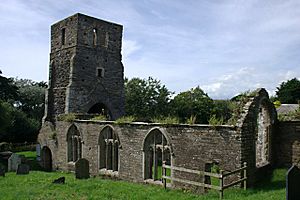St Andrew's Church, South Huish facts for kids
Quick facts for kids St Andrew's Church, South Huish |
|
|---|---|

The ruins of St Andrew's Church, South Huish,
from the southeast |
|
| Lua error in Module:Location_map at line 420: attempt to index field 'wikibase' (a nil value). | |
| OS grid reference | SX 695 411 |
| Location | South Huish, South Hams, Devon |
| Country | England |
| Denomination | Anglican |
| Website | Friends of Friendless Churches |
| History | |
| Dedication | Saint Andrew |
| Architecture | |
| Functional status | Ruin |
| Heritage designation | Grade II* |
| Designated | 26 January 1967 |
| Architectural type | Church |
| Groundbreaking | 13th century |
| Completed | 15th century |
| Specifications | |
| Materials | Slatestone |
St Andrew's Church is a very old church in South Huish, Devon, England. It is now a ruin, meaning it doesn't have a roof and is partly broken. This church is special because it's listed as a Grade II* building. This means it is very important historically. A group called the Friends of Friendless Churches helps take care of it.
Contents
The Church's Early History
The main parts of the church, called the nave (where people sit) and the chancel (near the altar), were built in the 1200s. Later, in the early 1400s, the tall west tower was added. Some changes were made to the church in the late 1400s or early 1500s.
Building More Sections
Around 1520 to 1540, a new porch and a south aisle (a side section) were built. Inside, a beautiful wooden screen called a rood screen was put in. This screen separated the nave from the chancel. Another screen divided the south aisle from the lady chapel. A small opening, called a squint, was cut into a wall. This allowed people in one part of the church to see the service happening in the chancel.
Church Bells and Changes
In 1553, records show the church had four bells. By the early 1800s, this number had grown to six bells. However, by 1866, the church building was in bad shape. Many people had moved from South Huish to a nearby village called Galmpton.
Moving the Church's Treasures
Because the old church was too damaged to fix, a new church was built in Galmpton. The bells and the font (a basin for baptisms) were moved to the new church. St Andrew's Church was then left empty. Other important items were also moved or sold. A beautiful medieval screen went to a house called Bowringsleigh House. Parts of the south aisle went to a church in Dodbrooke. Even the carved ends of the church benches were taken to Powderham Castle.
What the Church Looks Like Now
The church is built from slate stone. It no longer has a roof, but most of its walls are still standing. You can see a blocked-up doorway on the west side. Above it is a damaged window from the Perpendicular Gothic style. There is also a round-headed porch on the south side. This porch was built in the early to mid-1500s. It has stone benches along its sides.
Inside the Ruined Church
Inside, almost all the old features have been removed. However, in 2005, experts did a survey of the ruins. They found three special brackets that once held statues or images. These were in the porch, the nave, and the lady chapel.
Recent Efforts to Preserve the Church
In 1976, a charity called the Friends of Friendless Churches took over the care of the ruins. They have a very long lease, meaning they will look after the church for many, many years. Soon after they took over, the top 8 feet (about 2.4 meters) of the tower were removed to make it safer.
Protecting the Ruins
In 1988, one of the granite windows was put back together using stones that had fallen from the building. Work has been done to slow down how quickly the remaining parts of the church decay. Even though it's a ruin, a church service is still held there once a year.

